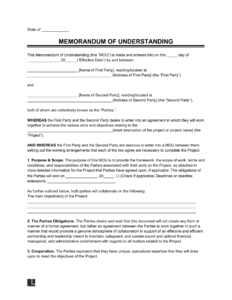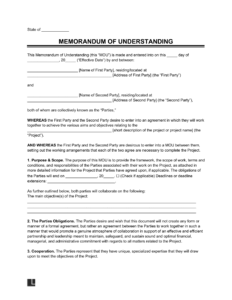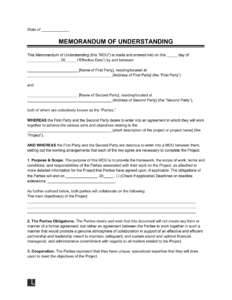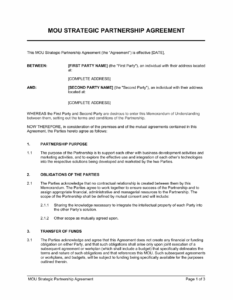Embarking on a collaborative research project is an exciting endeavor, full of potential for groundbreaking discoveries and shared innovation. However, like any significant partnership, research collaborations thrive on clarity, mutual understanding, and a well-defined framework. This is precisely where a research memorandum of understanding template becomes an invaluable tool, setting the stage for a smooth and productive journey for all parties involved.
A Memorandum of Understanding, often referred to simply as an MOU, is a document that outlines the agreement between two or more parties. In the context of research, it serves as a non-legally binding agreement that details the intentions, expectations, and responsibilities of each collaborator. It’s designed to foster a spirit of cooperation and prevent misunderstandings before they even arise, ensuring everyone is on the same page from the outset.
Why a Research MOU is Indispensable for Collaborative Projects
Think of a research MOU as the blueprint for your collaborative project. It might not be a legally enforceable contract in the strictest sense, but its power lies in its ability to clarify roles, responsibilities, and the overall scope of the research. Without such a document, partners might operate under different assumptions, leading to friction, delays, and even the unfortunate dissolution of promising projects.
The benefits of utilizing a comprehensive research memorandum of understanding template extend far beyond simply avoiding conflict. It helps streamline communication by establishing clear channels and points of contact. It also ensures that critical aspects like resource allocation, data sharing protocols, and publication authorship are discussed and agreed upon upfront, preventing awkward conversations and disputes down the line.
Key Elements of an Effective Research MOU
While each collaborative project is unique, a robust research memorandum of understanding template should typically address several core components to be truly effective. These elements provide a structured approach to outlining the partnership:
- Identification of Parties: Clearly state all individuals, institutions, or organizations involved in the collaboration.
- Purpose and Scope of Research: Define the project’s objectives, the specific research questions to be addressed, and the overall scope of work.
- Roles and Responsibilities: Detail what each party is expected to contribute and what their specific duties will be.
- Intellectual Property (IP) Rights: Outline how intellectual property generated during the research will be owned, managed, and utilized.
- Confidentiality and Data Sharing: Establish protocols for sharing sensitive information and research data, including access and storage.
- Publication and Authorship: Define guidelines for attributing authorship in publications and presentations arising from the research.
- Resources and Funding: Specify any financial contributions, equipment, or personnel resources provided by each party.
- Timelines and Milestones: Set out a proposed timeline for the project, including key milestones and deliverables.
- Dispute Resolution: Outline a process for resolving any disagreements that may arise during the course of the collaboration.
- Term and Termination: Specify the duration of the agreement and the conditions under which it can be terminated.
By thoughtfully addressing each of these points, a research memorandum of understanding template acts as a powerful tool for aligning expectations and fostering a transparent environment. It transforms abstract intentions into concrete understandings, paving the way for a more productive and harmonious research experience.
It is important to remember that while an MOU is not a contract, the act of drafting and agreeing to its terms demonstrates a serious commitment from all parties involved. This shared commitment is the bedrock of successful scientific and academic partnerships, making the MOU a foundational document for any joint research endeavor.
Crafting Your Own Research Memorandum of Understanding Template
While readily available templates can provide an excellent starting point, the true value comes from customizing a research memorandum of understanding template to fit the unique specifics of your project. Generic templates are helpful for structure, but every collaboration has its own nuances, from the specific nature of the research to the institutional policies of the involved organizations. Take the time to tailor each section, ensuring it accurately reflects the agreements made between all parties.
The process of customizing your template should involve open discussions with all collaborators. This isn’t just about filling in blanks; it’s an opportunity to thoroughly discuss potential challenges, clarify expectations, and forge a unified vision for the project’s future. Consider scheduling dedicated meetings to go through each section of the template, allowing everyone to provide input and raise concerns. This collaborative drafting process itself strengthens the partnership, building trust and shared ownership.
- Start with a solid foundation: Begin with a comprehensive template that covers all the essential aspects of a research collaboration.
- Engage all stakeholders: Ensure representatives from all participating parties are involved in the customization process.
- Be precise and clear: Use unambiguous language to define terms, roles, and responsibilities, avoiding jargon where possible.
- Consider future scenarios: Think about potential issues like scope creep, unexpected delays, or changes in personnel, and how the MOU addresses them.
- Seek expert advice: For complex projects, especially those involving significant intellectual property or funding, consider consulting legal or institutional review boards.
Remember, a well-crafted research memorandum of understanding template isn’t just a document to sign and forget. It should be a living guide, revisited periodically to ensure it still accurately reflects the project’s direction and the evolving needs of the collaboration. This proactive approach ensures the MOU remains a relevant and effective tool throughout the entire research lifecycle.
Ultimately, investing time and effort into creating a clear and comprehensive research memorandum of understanding provides a solid framework for any joint academic or scientific undertaking. It fosters an environment of trust, transparency, and shared purpose, dramatically increasing the likelihood of a successful and impactful collaboration. By laying down clear expectations and guidelines, you empower all participants to focus on the exciting work of discovery, knowing that the operational aspects are well-defined.
Embrace the opportunity to proactively define your collaborative journey. A thoughtfully prepared MOU not only mitigates risks but also strengthens partnerships, allowing researchers to concentrate on what they do best: pushing the boundaries of knowledge and innovation together.



